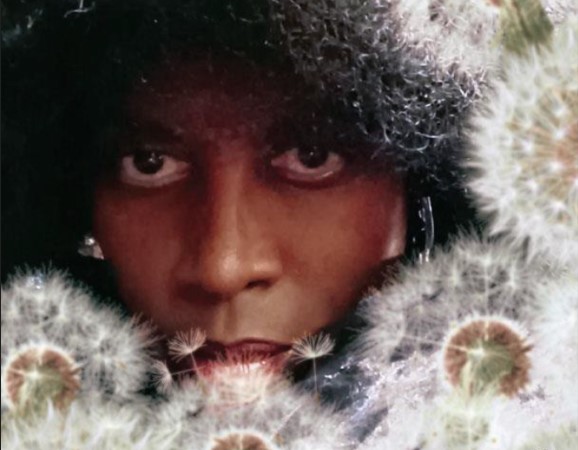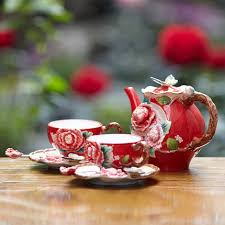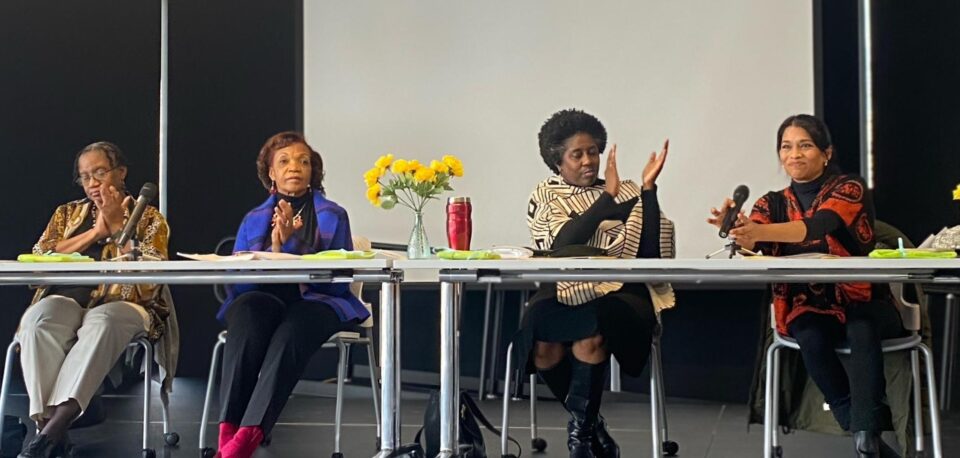Featured photo: Panelists who spoke at the Community Wide Convergent Voice Workshop, held at the Flint Public Library
April is National Poetry Month, 30 days of celebrating joy, expressiveness and pure delight of poetry, according to ReadingRockets.org!
In celebration of National Poetry Month, the Courier is sharing “Black Dandelion,” the highly acclaimed poem by Semaj Brown, as well as papers written by panelists at a local event in response to the poem.
Black Dandelion

By Semaj Brown
Age four— Witnessed my first mow down
Twinkling ground stars, cut by a murderous lawn mower
Feeling the blade, I fell, curled like a snail in grief
12 full moons folded into Spring — Perennial promises prevailed
Bees celebrated return of dandelions in a skirt of twirling, yellow bliss
Flowering bouffant mirrored my spiky little afro
Jagged edged “lion’s tooth” leaves paid tribute to my snag-a-tooth smile
Me and my freedom fighting flowers frolicked to survive the
scissoring, up-digging, poisoning
Warning Signs hovered like low hanging clouds:
No Blooming Allowed; Blossoms Will be Prosecuted
These brave plants grew just for me
Grew in spite of a society that favored a monochromatic landscape
1965— Mr. Brother Malcolm X was assassinated, big word for a pre-kindergartner.
I was convinced he must have been a dandelion, Reverend King too,
and the Johnson boy who lived one turn down the street, that way.
The Johnson boy was shot by the police for growing in a monochromatic landscape.
Training Wheels Off—Bike riding across insecure cement, I peddled the bumpy path
waving solidarity to each surviving, sunburst noggin,
each fulfilling the promise to ornament lawns and flourish souls with lemon drop hope
Dandelions bare art of
endurance and escape
transforming into pearl puffs
floating with ephemeral intention
carrying the spirit of the weed.
13 Full moons faded into July — “I am a proud weed!”
Yes, I declared that shocking proclamation standing in the pulpit on Youth Sunday
Vernon Chapel A.M.E. Church
I added to my speech on David and Goliath
my impromptu improvisation of Dandelion Dogma:
“We are Black Dandelions who will NEVER be destroyed.
We grow the power of goodness for generations into the future!”
I yet remember the hat framed faces of the pious, amused and mortified.
The following papers were written in response to the poem “Black Dandelion” by panelists who participated an event held at the Flint Public Library, The Community-Wide Convergent Voice Workshop.
Darolyn Brown is a poet and novelist. She hails from Detroit, Michigan and holds a master’s Degree in English from Wayne State University. She was a teacher of English and creative writing (Poetry) for almost 35 years in the Detroit Public Schools. She enjoys working with the Flint Reads Pod Poetry Project (P3) as a literary consultant because she will not pass up an opportunity to bring poetry to the people. In fact, it is her life’s work.

Meaning: A Key to a Poem’s Heart
By Darolyn Brown
The way a poem is written helps to convey meaning because one can glean meaning from content. If there is an unfamiliar word in the stanza, the surrounding words will provide a clue to its meaning. This poem, “Black Dandelion”, is filled with very vivid clues.
As one reads, the mind tries to put ideas together, in order. When an unfamiliar word crops up, the mind is already associating it into the context. The words “twirling” and “return” help the reader suspect that the unfamiliar word perennial means continually recurring.
Looking up unfamiliar words will guarantee success in understanding the poem’s full intent. Instead of having to surmise meanings, one can pinpoint them and realize the poem’s full impact. For example, monochromatic, is used in the poem twice. It must be important. It is being stressed. Society favored a monochromatic landscape and the Johnson boy was shot by the police for growing in a monochromatic landscape. There is obvious something dangerous about a landscape that consists of only one color, as monochromatic is defined, or in a larger sense one way to be.
In continuing to glean meaning from the poem, one can notice that first the dandelions were mowed down and later prosecuted. Then we see that Malcolm X and Dr. Martin Luther King, Jr were assassinated – which means- the act of murdering a famous person in a surprise attack- as the poem says a big word for a pre-kindergartner, but in looking it up, we see it is exactly the right word. So, again looking up unfamiliar words helps the reader embrace all the significance of what is going on in the poem.
Being familiar with the meanings of unfamiliar words also adds to the mood or tone of the poem. The meanings of the words solidarity and endurance put together creates a mood of strength. And they are seamlessly joined by the word ephemeral which says that they are only meant to last a very short time. But, understanding what solidarity and endurance means, one knows that the ephemeral is just an illusion and the dandelions will overcome and succeed through the spirit of the weed.
The poem, “Black Dandelion”, is a beautiful poem that packs a whole lot of meaning. One can understand the poem through sensing the context of the words, phrases, and ideas. But, one can fully realize and interact with the subject of the poem by looking up unfamiliar words. They have all been chosen for their exact meanings and connotations and placed specifically where they will give one the true meaning of the poem.
Sonya Pouncy is a Callaloo Fellow with a Master of Arts from Central Michigan University. Her poetry has appeared in journals including Callaloo, Temenos, Aunt Chloe: A Journal of Artful Color, Drum Voices Revue, and in the anthologies Respect, Poet in the House, and Abandon Automobile.

Sonya is also an engineer with 20+ years of experience in the HVAC industry. Her firm, Building Vitals, helps facility managers identify, understand and bridge the gap between where their building performance is and where they want it to be.
Equality, Empathy and Energy in Semaj Brown’s Black Dandelion
By Sonya Pouncy
Poetry is a special kind of lens that allows us to see and understand things differently than we would otherwise. It bends the light emanating from things so we can see their component colors and nuances. It also concentrates and focuses that same light so that we see things more clearly, more wholly. To do this work, poetry uses several devices. Chief among them is the metaphor.
Metaphor is a type of figurative language that makes comparisons between things. We make comparisons to understand things more fully. With metaphors, the comparisons are often between things that, on the surface, appear very dissimilar. But metaphors show us how the things—usually two, but it could be three or more—are more alike than we originally thought.
Similes make comparisons, too. But they use helper words, such as “like” or “as” to let you know they’re making a comparison. For example, in Line 3: “I fell, curled like a snail in grief” and in Line 10: “Warning signs hovered like low hanging clouds.” Metaphors, however, make their comparisons differently. On one hand, they are more subtle because they do not use helper words and on the other hand, they are more forceful because they don’t say one thing is like another, instead they assert that it is the other. Metaphors set up an equality. Metaphors make things equal.
For example, in the “Flowering bouffant” of Line 6, without even using the word dandelion, the flower is described in such a way that we see how it is like an afro, even before we are told that it mirrors the narrator’s afro. (Technically speaking, this is metaphor mixed with metonymy, but we’ll save that discussion for another time).
Or, in Line 15, when referring to Malcolm X, the narrator says: “he must have been a dandelion” inviting the reader—that’s us—to think about not only how Malcolm X was like a dandelion, but also how the dandelion is like Malcolm X. And, how dandelions are also like Martin Luther King, Jr. This comparison is particularly interesting because—if we remember the transitive law from math class—if Malcom is equal to a dandelion and Martin is equal to a dandelion, then Malcom is also equal to Martin. In the media, these two men, who only met once and only for about 60 seconds, are often depicted as polar opposites. But with this ever so subtle metaphor, Semaj asks the reader to ponder their similarities, what they had in common, how they were, in fact, the same. And if your mind wasn’t blown by that, it must surely be blown when she also asks you to consider how Malcolm and Martin are like the “Johnson boy,” since he’s a dandelion, too.
Semaj also invites us to explore how we are like the narrator. She does this with another poetic device, the persona. The narrator is speaking in first person. We often assume this means the narrator is also the author, but this is not necessarily so. Regardless, use of the words “I,” “my,” and “me,” places the reader in the poem because when we read the poem, we don’t replace those first-person pronouns with third-person pronouns. We say “I”, too. We say, “me” and “my.” By saying those words, a switch is flipped in our brains that allows us to imagine ourselves as the person in the poem. We get to walk in the narrator’s metaphorical shoes. And Semaj makes that easy for us, because even if we hadn’t thought much about dandelions before encountering the poem, she introduces typical childhood events with which we very likely can identify. The narrator speaks of being “snag-a-tooth” (17), riding a bike for the first time without training wheels (18), and giving a speech on Youth Day at your house of worship (29-32). When I was a child, my church didn’t have a Youth Day, but I vividly remember dressing up and going to my great-grandmother’s church to give my Easter Speech every year.
By allowing us to walk in her or his shoes for a while, the narrator invites us to identify and empathize with her- or himself: to understand his or her feelings from the inside. We feel them, too. We feel the narrator’s pain at witnessing that “first mow down” (1) and we, too, want to curl up “like a snail in grief” (3). We may not struggle with saying “assassinated,” but we can feel how that is a “big word for a kindergartner” (14). It’s a heavy word, even for an adult (note, that heavy was a metaphor).
Not only do we share the feelings of the narrator, we share the energy, too. We also get to frolic (8), we also get to pedal, ride our bikes, and wave to the dandelion’s “surviving, sunburst noggins” (18-20). And, triumphantly, we also get to stand firmly, resolute with shoulders back—even though the poem doesn’t say this, this is how I imagine myself to stand when I declare with the narrator that “I [too] am a proud weed”, that I, too, am among the “Black Dandelions who will NEVER be destroyed” (34).
One final point about the narrator’s energy. If we recall from physics or science class, energy is defined as the ability to do work. So, because this poem has energy, has “intention,” this poem works. Some poems are whimsical, just for play and that’s fine. But this poem is not and it tells us so using yet another poetic device, personification—the giving of human attributes to something not human. The poem tells us that:
“Dandelions bare art of
endurance and escape
transforming into pearl puffs
floating with ephemeral intention
carrying the spirit of the weed.” (23-27)
Notice the almost imperceptible sleight of hand here that might, at first glance, be mistaken as a malapropism. The dandelions “bare [the] art of endurance and escape,” but it’s not B-E-A-R, as if they were carrying the weight of endurance and escape. It’s B-A-R-E, as in they are laying something bare for us. They are uncovering, the “art of / endurance and escape.” They are making known something that was unknown because there is something the poem wants us to understand. That is that enduring a thing and escaping a thing are intrinsically connected. That together they are an art—an activity that stimulates thoughts, emotions, beliefs, and ideas. And, that their art is exemplified in the cunning and persistence of the dandelion, and is similar to the way David prevailed over Goliath.
Everyone one of us, no matter how young or old, has something that we’ve had to endure or escape, something we’ve had to grow “in spite of.” It may be weighty, like knowing someone like “the Johnson boy who lived one turn down the street, that way” who “was shot by the police” (16-17). Or, it could be as light and airy as the “amused and mortified” stares of “hat-framed faces” (36-37) on a Sunday afternoon. What have you endured and escaped? How have you or how has someone you know “transformed into pearl puffs. […] carrying the spirit of the weed (25-27)? In what ways are you, too, a dandelion?
Sunanda Samaddar Carrado is a senior disciple of the renowned Nritya Sudha’s Hindu Temple Rhythms (HTR), a classical Indian dance school that promotes the Tanjore style of Bharata Natyam. Sunanda was a former principal dancer for the Odissi Classical dance company, Nayikas, in New York City from 2005 – 2009. Sunanda received her doctorate in anthropology from Columbia University. Her art, academics and activism engages themes such as youth, education, global capital, local autonomy and resilience.

Dandelion Garden: A Walk though Convergent Consciousness
In celebration of Women’s History month, I chose to explore the allegory of the Black Dandelion. Specifically, I wanted to reflect together about how a flower can also exist as a weed.
Immediately, my mind begins to circle: What is women’s history? What does it look like? If you were to ask the same question in school, the idea splinters further: there is feminist history, theories of performativity, queer theory etc. If you go to seminary or take an African American lit class, you may finally stumble across Womanism. So let’s drop what we think is familiar, and I ask the question, at a much later stage in my own life, Is womanist history not a Black Dandelion?
The term ‘womanist’ was first introduced by author and activist, Alice Walker, in her 1982 publication In Search of Our Mothers’ Gardens: Womanist Prose. Since then, literary scholars have begun to conjure a voice from the past, between the shores of memory and amnesia, humiliation and triumph, a truth in the form of ghosts and goblins. Womanism is rooted in the history and everyday experiences of Black women. Womanism seeks to explore the imbalance between people and nature, reconciling human conflict with the spiritual dimension of our collective immortality.
Afterall, Black women experience more violence, for lower pay. Sisters who are fetishized objects of repressed desires who find little reflection of their own realities in the media and political representations. Because mainstream feminism does not address racism or desire, a parallel, womanist movement formed to acknowledge Black women’s struggle for humanity – for themselves, their children, their lovers and their brothers. Just as Christ’s body was shared and consumed, is the Black woman’s blood not wine? Is the wafer offered not an issue of her own flesh?
Semaj Brown’s Black Dandelion is very much reminiscent of – and harnessed to – the same mutilation, pain and disembodiment of the Black Woman’s body even as she celebrates the triumph of the Black Dandelion’s beauty and her rich botanical treasures.
What is in a name? White or Black? What if a flower were to be referred to as a weed? And why is this flower sentenced to such derision? Is it because of the Black Dandelion’s unrelenting spirit or is it because of her unconscious intrusion into our collective Conscience? How does her longing, to return to where she had once and will always belong, infect me with such melancholy?
Even as Alice Walker describes her mother’s gardens as the blossoming sieve through which she experienced an impoverished childhood: she continues to describe every Black woman’s experience in viscerally straggled terms. A double consciousness of sorts, like a square circle, even as Ms. Walker’s mother struggled, she created without force of effort. Ms. Walker declares that her mother was not a saint, but in fact an artist with intuit beauty made manifest in bleakness. Alice Walker’s mother gave life to gardens in the gallows, even as she birthed, harvested, scrubbed and swept, quilted, sewn, or cooked, she created. Alice Walker’s mother was never a saint, she was always the Creator.
Similarly, Semaj Brown writes:
Dandelions bare art of
Endurance and escape
Transforming into pearl puffs
Floating with ephemeral intention
Carrying the spirit of the weed (lines 23-27).
And how do we mean the spirit of the weed? Is the dandelion not a flower? What is this transformation? What is the “spirit of the weed”? At the beginning, did the poet not liken the flower to her four year old narrator?
Flowering bouffant mirrored my spikey little afro
Jagged edged “lion’s tooth” leaves paid tribute to my snag-a-tooth smile (lines 6-7)
Sweet, innocent, gawky and mischievous, how did this child-flower come to carry the spirit of the weed? Towards the end of the poem the little girl says:
…”I am a weed!”
Yes. I declared that shocking proclamation standing
In the pulpit of Youth Sunday
Vernon Chapel A.M.E. (lines 28 – 31)
I yet remember the hat framed faces of the pious,
amused and mortified (lines 36 – 37)
Notice Mrs. Brown’s own use of contradiction: “amused and mortified,” For the girl child spoke to a congregation of weeds. Yet, how does a flower come to perceive herself as a weed, even as the congregation sits before her in bewilderment? Could it be because of what happened to:
… the Johnson boy who lived one turn down the street. that way.
The Johnson boy was shot by the police for growing in a monochromatic landscape.
(lines 16 – 17)
Perhaps, in WEB DuBois words, she was: “born with a veil, and gifted with second-sight.” Not able to live her own, self-conscious life, the girl child with her “training wheels off (line 18)” must “ride across insecure cement (line 18).” She pedals “the bumpy path waving solidarity (lines 19 – 20)” to her dandelions in existential torment for Malcolm X, Martin Luther King and the Johnson boy.
In Langston Hughes’ The Ways of White Folks, he skillfully weaves womanist prose into each of his short stories. These are intimate stories of asymmetric love and perpetual loss. How does one convey such pain from just a pile of words? How does Womanist prose conjure a parallel spirit world reality? He writes from the voice of Oceola:
“This is mine… Listen! How sad and gay it is. Blue and happy – laughing and crying … ho white like you and black like me …How much like a man … And how much like a woman … These are the blues I’m playing.
However, Alice Walker beckons for us to surf the waves of binary bifurcations. For all such contradictions are folded into a paradox of existence where “Blossoms will be prosecuted!” (line 11). A world filled with Death and fertility, childhood innocence and “Dandelion Dogma.” You see, these shorn petals disguise the existence of the whole flower, for 12 full moons later: “Perennial promises prevailed” and the “Bees celebrated return of dandelions in a skirt of twirling bliss” (lines 4 – 5).
Alice Walker mused that such a schizophrenic existence between life and death cultivates a certain brilliance in a Black woman’s creativity. Stunted perhaps at first, but then unknowingly, unceasingly, unconsciously evolving within an environment where being perceived as a weed is the norm, is expected. What else could you be as a Black American? Like Moon Flowers, the Casablanca Lilies or the Nottingham Catchfly or the Evening Primrose, throughout history, Black women have learned to bloom only at night, sometimes without one ray of hope or transcendent light beam to caress her soft and delicate petals.
Similarly, reference to a Black Dandelion only blooms at the end of the poem. Whereas the journey through the poem aligns the beauty of the dandelion’s deep golds and myriad shades of yellow with brightness, light and vulnerability – conspicuous to our conscience, mowed down by murderous blade; Each individuated dandelion is either mourned or saluted by the girl child who continues to develop into consciousness in the midst of violence of 1965 to 1966. However, by the end the child reclaims the principle of being a flower as her Dandelion Dogma. Standing before her church, she declares:
“WE are Black Dandelions who will NEVER be destroyed.
We grow the power of goodness for generations into the future!” (lines 34 – 35)
This simple and strange declaration rearranges and resignifies the images of the dandelion, seeping into the previous stanzas of the poem in three brilliant ways: Firstly. The Black Dandelion is about the girl child actively transforming her own reality, seeing connections between the violence against her people as parallel to the violence she witnesses against Nature. Secondly, the lives of these lone dandelions targets are resurrected in the pronouncement of “We.” For the line “we shall never be destroyed” conveys the resilience of the indestructible soul, perhaps a cruel revelation, how her ancestry is the ancestry to ALL is in the ironic iteration of Blackness as conveying a conscious mind to the Dandelion, and its collective reality. Thirdly, the child inverts the social meaning and value of the dandelion, declaring herself not only to be a weed but that in fact a Black weed, a double negative, one might think, at once internalizing larger social standards in triumphant subversion.
For even as flowers are mowed down, banished from the garden of men and power, they survive, and most impudently thrive, perforating neighborhood lawns with scrawny stems and snag-a-tooth smiles. Mrs. Brown at once transforms the survival of the dandelion with the lynchpin of earthly existence. This child, divided from within, torn from her women’s ancestry, bamboozled by beauty standards that aim to control her body’s reproductive and hard labor; This child – makes visible through imagination, a rapacious and ugly system that envies what they have for so long leered as Blackness. Scraping men and women of their memory, of their right to divine rule, decapitating crowns of autonomy and self-expression: demanding that these petals be straightened or covered – even as they speak against covered heads of other women from other worlds, Black Dandelion is at once at odds and in sync with human destiny.
The reality is that there exists no such thing as a weed, there exists no such thing as Black and White. Blackness is the seed from which all reality is made manifest. These weed ideas are transformed and transcendent “pearl puffs”, not by Nature directly, but by the shared circuitry of possessive guilt and demonic denial of what is obvious to the little girl: that unruly nature cannot be ruled. These ideas of rule and order bear no seed of life. Yet, these diseased perception only seem to entangle and evolve through Nature’s own will to be free.
BLACK DANDELION: CONVERGENT VOICE™ | © Health Collectors, LLC



